Vermont Public Lab Organizing: Toxics Action Center and Public Lab!
We will be organizing a Public Lab support network for Toxics Action Center's organizing in Vermont using PLOTS tools. If you're interested in helping out please add your contact information below. Sara and Chris Fastie will be in touch.
Research Notes with the tag "TAC"
.
Potential sites for Public Lab tool use in Vermont
• Moretown- existing landfill that is reaching capacity and proposing an expansion that would double its current operating size. Issues include offsite odors, ground water contamination and structural damage from blasting. Potential tools: 1. Hydrogen Sulfide 2. Aerial Mapping 3. Spectrometer (well water testing)
• Graniteville- neighborhood fighting a proposed asphalt plant. Potential issues include toxic air emissions, particulate matter and truck traffic. Potential tools: 1. Aerial mapping (to illustrate proximity of household and schools to proposed sight)
• Williston- residents who neighbor a shooting range are trying to urge the gun club and state to clean up existing lead pollution. Issues include well water contamination from lead. Potential tools: 1. Spectrometer (brook and well water testing)
• Wells- residents are working to urge the Lake Association to stop using herbicides to control weeds in Lake St. Catherine. Group is looking for a way to illustrate harmful effects of herbicides on lake health and ecology. Issues of concern include human health threats from use of herbicides in the lake. Potential tools: 1. Spectrometer
• Cabot- community members are urging Agrimark (Cabot Creamery) to abandon their practice of land application of industrial waste water. Issues of concern include effect of chemical and contaminants on soil, groundwater and nearby streams and rivers. Potential tools: 1. Infrared imaging
• Vermont Yankee (nuclear power plant). Issues include thermal pollution from cooling towers into Connecticut River. Potential tools: 1. Thermal pollution photography
Additional local campaigns; • Springfield- community members are working to stop a proposed large scale biomass incinerator from developing in their neighborhood. Issues of concern include air pollution, particularly particulate matter, impact on water supply, and truck traffic. • Junkyards, statewide- Toxics Action Center has worked with several communities that are working to clean up pollution from illegal junkyards. Concerns with poorly operated and maintained junkyards include potential water and groundwater pollution from materials stored on site, soil pollution of heavy metals, and risk of fire due to storage of tires.
To get involved, just edit this page to answer these questions:
Public Lab Username?: blackbear1025 Email?: slewis4 atsign uvm.edu Connection to Vermont?: UVM Student How might you want to be involved?: Would be willing to help in any way that I can fit into school schedule
Public Lab Username?: Email?: Connection to Vermont?: How might you want to be involved?:
Public Lab Username?: Email?: Connection to Vermont?: How might you want to be involved?:
Public Lab Username?: Email?: Connection to Vermont?: How might you want to be involved?:
Public Lab Username?: Email?: Connection to Vermont?: How might you want to be involved?:
